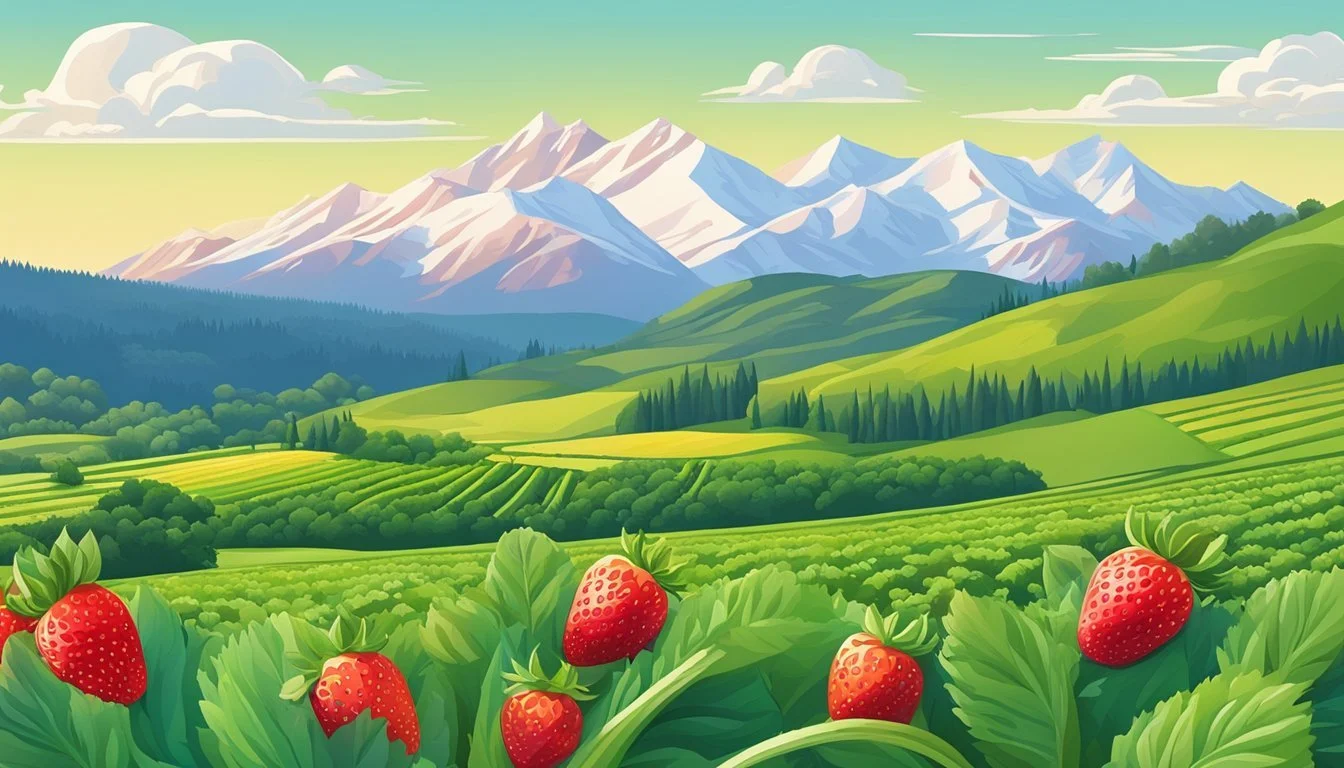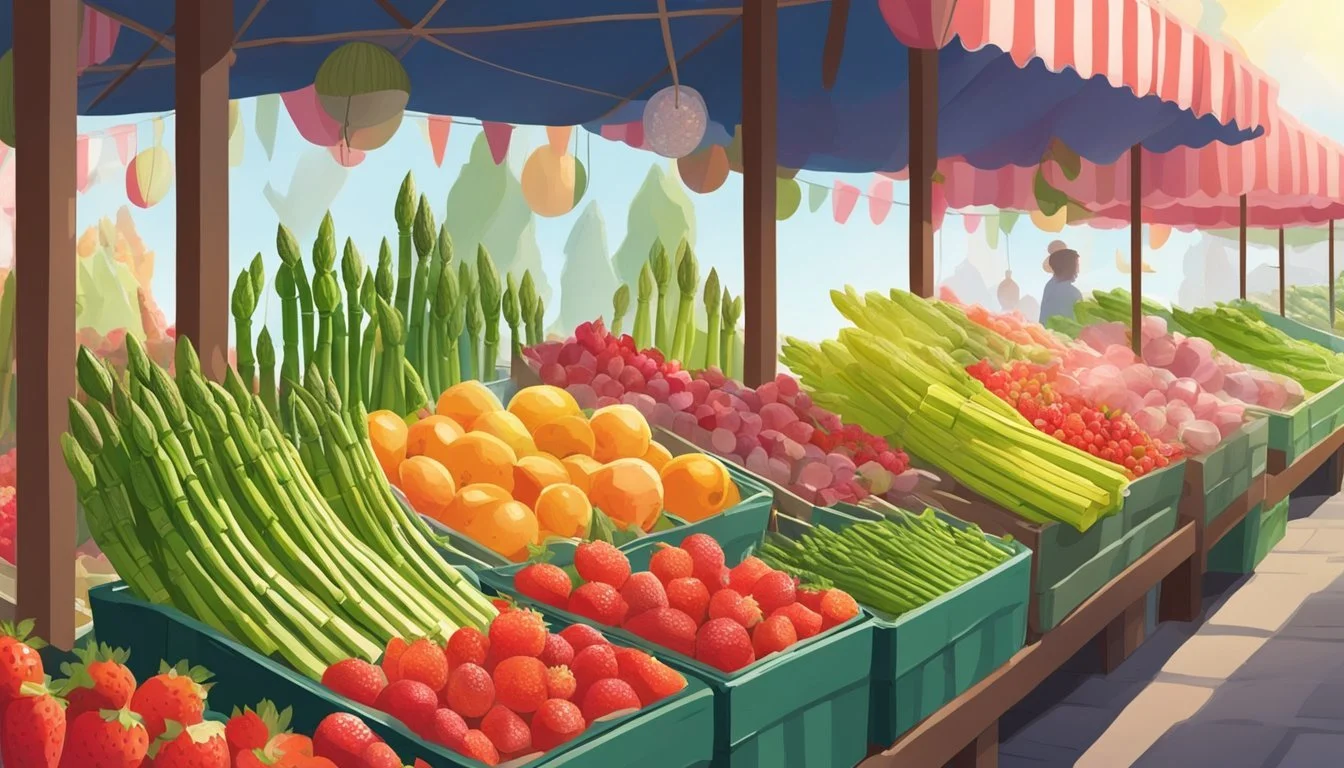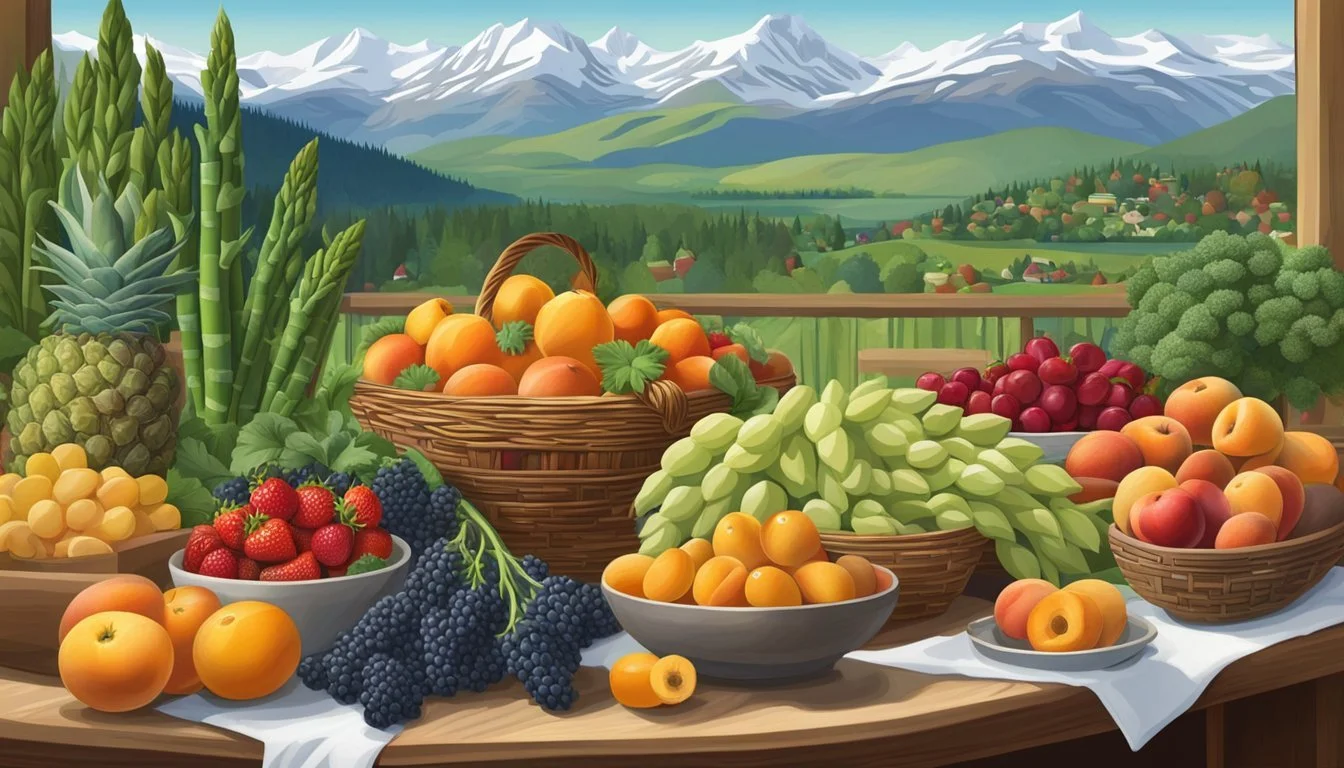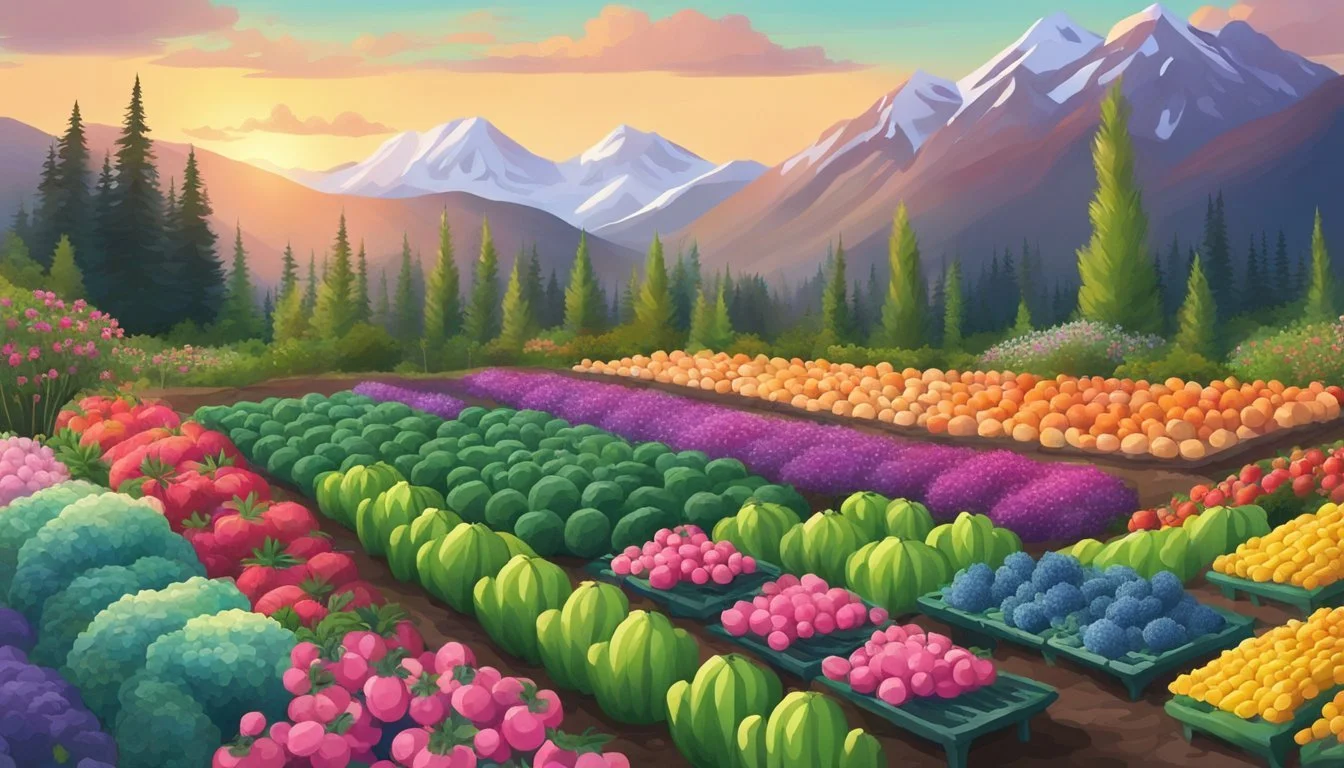Alaska Seasonal Fruit & Vegetables in May
Your Fresh Guide
This Article is Part of our Alaska Seasonal Fruit & Veg Calendar
Alaska's climate, characterized by short summers and long, cold winters, impacts the growing season and the availability of fresh produce. The state's unique daylight patterns, with extended hours of sunlight during summer, contribute significantly to the growth cycle of plants. As such, farmers diligently harvest the bounty of the season, especially during the warmer months.
By May, the Alaskan landscape begins to wake from its winter slumber, giving way to the early sprouts of seasonal produce. Gardeners and farmers markets ready themselves to offer a selection of cool weather crops. During this period, Alaskans can expect to find vegetables such as lettuce and rhubarb that withstand the still-cool temperatures. It's a time when the state's produce starts to flourish, providing a fresh offering to those eager to incorporate local ingredients into their meals.
Understanding Alaska’s Growing Seasons
In Alaska, the growing seasons are distinctively shaped by the state's high latitude and cold climate. The months from May to September mark the core of the Alaskan growing period, with each season bringing its own set of crops.
Spring in Alaska, although short, is a critical time for planting. By May, daylight begins to significantly increase, promoting the growth of a range of cold-hardy vegetables. This time of year is marked by the melting of snow and a gradual warming trend, although unexpected frosts can still occur.
Summer offers the most productive growing period, with long daylight hours providing a unique advantage for crops. The Alaskan summer—particularly late summer—is when the majority of fruits and vegetables reach their peak, benefiting from the nearly 24-hour daylight in some regions.
Fall in Alaska signals the need for rapid harvesting before the frost sets in. As the days shorten, growers work to collect the bounty of the summer months. The first hard frosts typically arrive by late September, marking the end of the typical outdoor growing season.
Winter brings a halt to most outdoor growing, yet some hardy greens and roots can be harvested from hoop houses or with the aid of a greenhouse.
Due to varying weather patterns and microclimates, Alaska is subdivided into different hardiness zones, allowing gardeners to determine which plants are most likely to survive in their specific region. For example, Fairbanks, with its continental climate, can often ripen varieties of produce that may struggle in colder coastal regions.
Season Typical Crops Spring Lettuce, Kale, Peas Summer Berries, Carrots, Zucchini Fall Cabbage, Cauliflower, Potatoes Winter Limited greenhouse production
One must always be attentive to the particular growing conditions of their locale to maximize the success of their gardening endeavors in Alaska.
Key Vegetables in Season for May
May in Alaska brings about the harvest of key vegetables that thrive in the chilly spring climate. This transitionary period provides optimal growing conditions for a variety of leafy greens and hardy root vegetables.
Leafy Greens and Salads
During May, the Alaskan soil nurtures a selection of nutritious leafy greens and salad fixtures. Individuals can find fresh lettuce varieties, including romaine and butterhead, which offer crisp textures for salads. Spinach and kale also peak during this time, presenting lush leaves packed with vitamins. With daylight hours extending, cabbage begins to flourish, adding heft to meals with its dense layers.
Lettuce (Romaine, Butterhead)
Spinach
Kale
Cabbage
Root Vegetables
The cold-tolerant nature of root vegetables makes them well-suited for Alaska's spring. Carrots, with their sweet, earthy flavor, become increasingly available in May. Garden staples like beets and radishes offer vibrant colors and a peppery kick to dishes. Turnips and potatoes continue to be reliable for their versatility in cooking. Additionally, onions, an essential aromatic base for countless recipes, persist in their availability from the previous season's cold storage.
Carrots
Beets
Radishes
Turnips
Potatoes
Onions
Root vegetables are particularly valued in Alaskan May harvests for their resilience to the lingering cold and their ability to be stored from previous seasons.
Seasonal Fruits Available in May
In May, Alaska's brief but vibrant summer begins to usher in a variety of fruits, with berry varieties starting to come into season, along with other robust fruit options such as rhubarb.
Berry Varieties
Strawberries: A highlight of Alaskan May is the beginning of the strawberry season. Fresh, ripe strawberries start to appear at this time, though they are often more plentiful towards the end.
Other Berries: While the full berry season has not yet peaked, there may be some early varieties of wild berries available in limited quantities.
Other Fruits
Rhubarb: Not a fruit in the botanical sense but commonly used as one in culinary practices, rhubarb reaches its peak in May. It is one of the few produce items that thrive in Alaska's climate, so it is widely available and used in a variety of dishes, from pies to compotes.
Planting and Harvesting Tips
When approaching the planting and harvesting of fruits and vegetables in Alaska during May, one must pay attention to soil preparation and pest management. These factors influence crop success and quality.
Soil Preparation
A gardener should ensure soil is rich in organic matter and well-draining to protect against the cold, damp conditions prevalent in May. It is prudent to incorporate composted manure or peat to increase the soil's fertility and structure. Prior to planting, testing soil pH and nutrient levels allows one to amend the soil accordingly to meet the needs of specific cold hardy and low-maintenance crops suitable for Alaska's unique growing conditions.
Cold Hardy Vegetables: Vegetables like kale and lettuce thrive in cooler temperatures and should be planted after the last frost.
Soil Warming: Black plastic mulch can be used to warm the soil, allowing for an earlier start to planting.
Pest Management
Effective pest management prevents crop losses due to insects and diseases prevalent during the Alaskan spring. Regular monitoring is key to early detection and control.
Aphids: These pests can be managed by introducing beneficial insects such as ladybugs or applying insecticidal soap.
Diseases: Fungicides may be required to control prevalent diseases, but proper plant spacing and air circulation are essential preventive measures.
Starting with resistant varieties and employing crop rotation also minimizes the risk of pests and diseases, safeguarding the harvest season.
Alaskan Cuisine: May Recipes
In May, Alaskan cuisine emerges from its long winter with a bright assortment of seasonal fruits and vegetables. Enthusiasts of fresh produce can look forward to recipes that include vibrant greens and early berries.
Spring Greens Salad with Berry Vinaigrette Freshly harvested greens form the foundation for this simple yet flavorful salad. Alaskan gardeners may find an early bounty of lettuce, spinach, and chard. These greens can be tossed with a homemade vinaigrette, infused with local berry juices such as highbush cranberry for a tart and sweet flavor profile.
Ingredients:
Mixed spring greens
Highbush cranberry juice
Olive oil
Vinegar
Salt and pepper
Grilled Salmon (What wine goes well with grilled salmon?) with Rhubarb Chutney May is not only promising for plants but also marks the beginning of the fishing season. The celebrated king salmon pairs perfectly with a tangy rhubarb chutney. Utilizing the early stalks of rhubarb, this chutney offers a balance to the rich, oily fish.
Ingredients:
Chinook salmon fillets
Fresh rhubarb
Sugar
Vinegar
Ginger
Garlic
Reindeer Sausage and Vegetable Skewers A playful twist on Alaskan barbecues, these skewers combine the richness of reindeer sausage with the crispness of May vegetables like bell peppers or the earliest zucchini. They make for a hearty and communal outdoor dining experience.
Ingredients:
Reindeer sausage, cut into chunks
Bell peppers
Zucchini
Olive oil
Seasoning mix
For dessert, resourceful Alaskans make the most of preserved fruits or early blooms with simple pastries or jams. These dishes not only showcase the season’s fresh flavors but also reflect the resourcefulness and traditions of Alaskan culinary practices.
Sustainable Gardening Practices
In Alaska, sustainable gardening practices in May can include efficiently using available space and adopting organic methods to enhance productivity and environmental health.
Companion Planting
Companion planting is a method where different species are planted in close proximity for pest control, pollination, providing habitat for beneficial insects, maximizing use of space, and to increase crop productivity. Benefits of companion planting include:
Pest Management: Certain plants can naturally repel garden pests or attract beneficial insects that act as predators to pests.
Soil Health: Companion plants can improve soil nutrients and structure, which is valuable in Alaska's varied soil conditions.
Examples of companion planting include:
Marigolds planted near vegetable crops to deter pests.
Planting legumes which fix nitrogen in the soil, benefiting other plants nearby.
Organic Methods
Organic methods emphasize sustainable and environmentally friendly gardening without the use of synthetic fertilizers or pesticides. They are essential in maintaining the long-term health of Alaska's gardens. Key components of organic gardening include:
Soil Enrichment: Use of compost, organic mulch, and green manures to enhance soil fertility naturally.
Pest Control: Adoption of natural pest control techniques like introducing predatory insects or using organic repellents.
Vertical gardening is a sustainable method that optimizes space especially in confined areas. It involves growing plants on trellises, fences, or other vertical structures and can be particularly effective for organic gardens where space is at a premium.
Benefits of vertical gardening include:
Increased Air Circulation: Helps prevent fungal diseases common in the cooler Alaskan climate.
Ease of Harvest: Provides easier access to plants for maintenance and harvesting.
By implementing companion planting and organic methods, gardeners in Alaska can create productive and sustainable gardens that thrive in the unique conditions presented by the Alaskan climate.
Food Preservation Techniques
When dealing with seasonal fruits and vegetables in Alaska, such as those harvested in May, effective preservation techniques extend the availability of these perishables throughout the year. People use various methods to preserve the quality and nutrition of produce.
Canning is a popular method that involves placing fruits and vegetables in jars and heating them to a temperature that destroys microorganisms and inactivates enzymes. This process creates a vacuum seal that prevents further contamination.
Freezing is another common technique for preserving produce. Fruits and vegetables are quickly frozen to preserve their taste, texture, and nutritional value. It is important to use proper packaging materials to prevent freezer burn.
Drying or Dehydrating fruits and vegetables removes moisture, inhibiting the growth of bacteria, yeast, and mold. Dehydrators or ovens can be used for this process. Dried produce takes up less storage space and can be stored for long periods.
Preservation Technique Description Storage Tips Canning Heating produce in sealed jars to kill microorganisms. Store in a cool, dark place. Freezing Quick-freezing to preserve quality. Use airtight containers or freezer bags. Drying Removing moisture to prevent decay. Store in airtight containers away from light.
Regardless of the chosen technique, it's crucial to follow safety guidelines to ensure the preserved food remains safe to eat. Following proper procedures can result in enjoying nutritious, flavorful fruits and vegetables year-round.
Horticultural Events and Workshops in May
During May, various horticultural events and workshops offer enthusiasts an opportunity to broaden their knowledge and engage with the community. The Alaska Master Gardeners are hosting a range of webinars throughout May, specifically designed to celebrate Alaska Native Plant Month. These webinars are held predominantly at noon and cover topics such as Respectful Harvesting, Landscaping with Native Plants, Backyard Insect Ecology, and Landscaping for Birds. The convenience of online attendance allows for broader community participation.
The workshops are affordably priced at $15 and require prior registration. Interested individuals are encouraged to sign up early to secure a spot and gain valuable insights into Alaska-specific gardening practices.
In line with current trends, traditional in-person workshops are being reimagined as virtual experiences to ensure safety and accessibility. The Plant Kingdom, for instance, is organizing virtual workshops which may include kits that complement the online learning experience.
Alaskan horticultural events are crafted to address the unique challenges gardeners face in the region, such as the short growing seasons and the yearly infestations of various insects. By participating in these events, gardeners can learn to optimize their practices for local conditions. It's through these educational opportunities that the community can connect and grow, ensuring the resilience and vibrancy of Alaska's horticulture.
Garden Planning and Design
When designing a garden in Alaska for planting in May, thoughtful planning is essential due to the unique climate and shorter growing season. Gardeners should consider both the functional layout and the aesthetic landscape of the garden to maximize efficiency and enjoyment.
Layout & Planning:
Sunlight Patterns: Map out sunlight exposure in the garden area. Most vegetables thrive with 6 to 8 hours of direct sunlight.
Soil Preparation: Test and amend soil with compost and fertilizers suitable for cool-season crops.
Drainage: Ensure the garden site has proper drainage to prevent root rot and fungal diseases.
Cool-Season Crops Planting Timeframe Notes Cabbage Late April - May Tolerant to frost Romaine Lettuce Late April - May Requires well-drained soil Brussels Sprouts Start indoors, plant out Needs a longer growing period Kohlrabi Late April - May Grows best in cooler temperatures
Design Elements:
Raised Beds: Useful for soil warming and better root development.
Paths: Allow for easy access and maintenance without compacting the soil.
Wind Protection: Incorporate natural barriers or structures to shield sensitive plants.
Maintenance Planning:
Watering Schedule: Regular watering is crucial, considering variable rainfall.
Crop Rotation: To reduce pests and diseases, rotate crops in differing family groups each year.
By maintaining focus on these fundamental principles of garden planning and design, Alaskan gardeners can enhance the productivity and beauty of their gardens throughout the growing season.
Understanding Pesticides and Natural Alternatives
When considering seasonal fruits and vegetables in Alaska during May, one must assess the use of pesticides and the role of natural alternatives. Pesticides, while effective in pest control, create a concern for both human health and the environmental impact.
In Alaska, where growing seasons are limited, the careful selection of pesticides is crucial. They must not only be effective against pests but also minimize harm to the ecosystem. This includes considering the persistence of chemical residues in the environment and the potential for bioaccumulation.
Natural alternatives to pesticides are gaining traction. These alternatives include:
Physical Barriers: Netting or row covers protect plants without the need for chemical intervention.
Biological Control Agents: Introduction of predators and parasites that naturally reduce pest populations.
Botanical Insecticides: Derivatives from plants, such as neem oil, which are less toxic to non-target species and degrade rapidly.
Here are some considerations for Alaskan growers:
Strategy Benefits Considerations Physical Barriers Non-toxic, immediate effect Requires installation and maintenance Biological Agents Sustainable, long term Requires knowledge of local ecosystems Botanical Products Biodegradable, less harmful May be less potent than synthetic pesticides
These methods aim not only to protect crops but also to sustain the delicate balance of Alaskan ecosystems. Growers are encouraged to integrate these practices to ensure the wellbeing of consumers and the preservation of the local environment.












